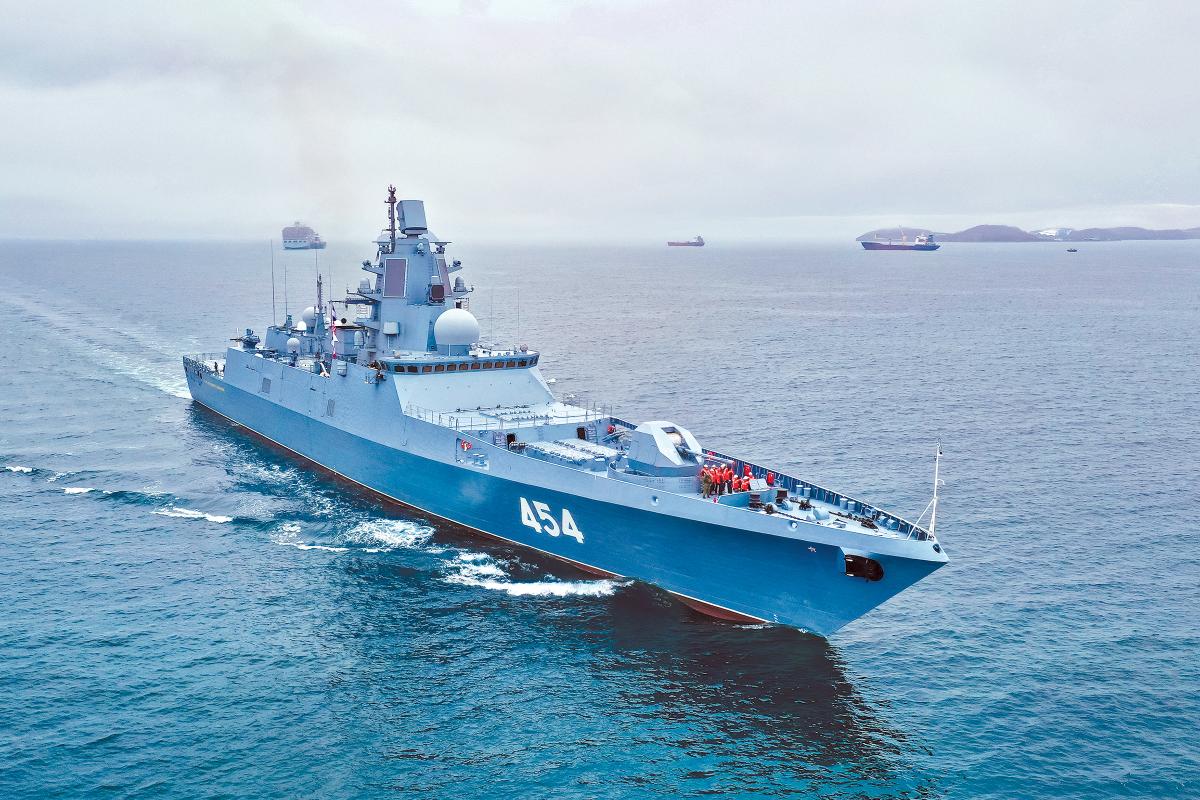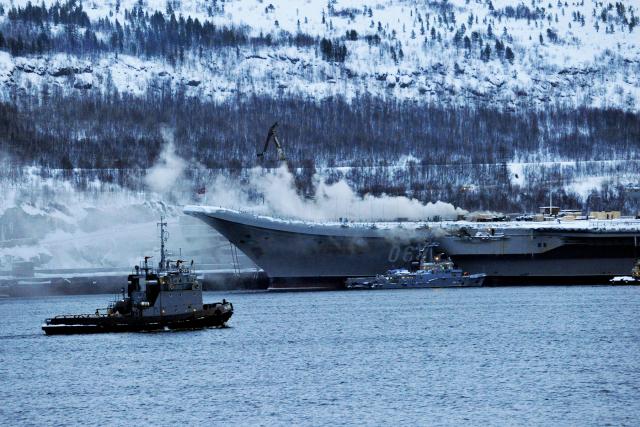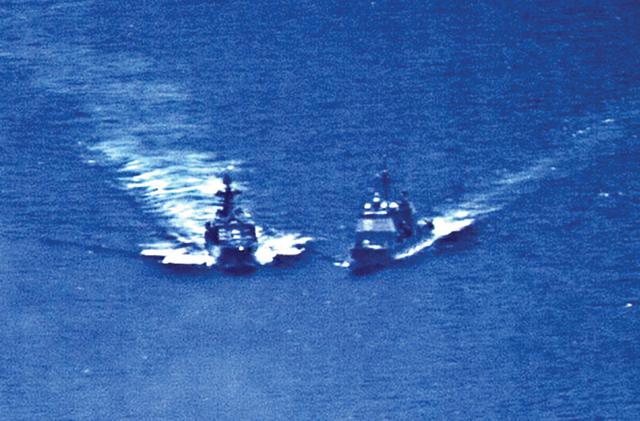The Russian Navy had an interesting 2019, and while it did not turn out to be the year the service hoped for in terms of major combatant procurement, there certainly were activities and exercises of note, as well as incidents that drew their fair share of negative publicity.
On the exercise front, August’s Ocean Shield 2019 proved to be Russia’s largest naval exercise in 30 years, followed by a sizable sortie of Northern Fleet submarines in October. The reports of the death of Russia’s submarine force, which occasionally crop up in Western media, appear to have been greatly exaggerated. A small task force, led by the frigate Admiral Gorshkov, circumnavigated the globe between February and August. The Russian Navy hopes such trips and the growing number of multinational exercises with countries such as China will become regular occurrences.
The most prominent incident at sea occurred in June, when a Russian Udaloy-class destroyer passed within 100 feet of the guided-missile cruiser USS Chancellorsville (CG-62) during a helicopter recovery operation in the Philippine Sea. Judging by how 2020 has begun, that 2019 episode is unlikely to prove to be an isolated incident.
The year’s most dramatic news came in July, when a fire killed 14 crewmen on board Russia’s special-purpose “nuclear deep-sea station.” AS-31, nicknamed “Losharik,” is a deep-diving nuclear- powered submarine that belongs to the Russian Defense Ministry’s Main Directorate of Deep-Sea Research (GUGI)—that is, Russia’s “other” navy, which conducts special projects. A fire broke out in the submarine’s battery compartment while it was docking with its mothership, BS-64 Podmoskovye, leading to an explosion. Losharik was saved, but much of the crew, consisting of senior officers (captains first rank), perished.
Russia’s unluckiest ship, the aircraft carrier Admiral Kuznetsov, continued its historical streak of incidents and accidents when it caught fire in December while pierside undergoing repairs. The Admiral Kuznetsov had been damaged in 2018 when the drydock it was in, PD-50, sank dramatically, almost taking the carrier with it. Not only did Russia lose its only drydock in the Northern Fleet capable of hosting the Admiral Kuznetsov, a crane from PD-50 fell onto the flight deck, causing further damage. The December 2019 fire appears to have caused minimal damage, much to the disappointment of many analysts and defense officials in Russia, who have come to see the ship as an albatross around the Navy’s neck. Despite everything the carrier has endured, many doubt if it will ever return to service as anything other than a floating museum.
At first glance, procurement in 2019 appears to have disappointed, but the lack of tonnage being launched disguises some positive shipbuilding trends for the navy. Russia’s defense industry delivered one improved-Kilo-class submarine for the Pacific Fleet, and launched a second, out of a total order of six expected. The Oscar-II nuclear-powered guided-missile submarine (SSGN) Omsk appears to have completed its overhaul and been restored to service. Several corvettes and guided-missile boats were launched, including the Vasily Bykov–class Dmitry Rogachev, Karakurt-class Sovetsk, and Buyan-M Ingushetia. It appears that two previously inactive amphibious warfare ships (LSTs) were repaired for the Black Sea Fleet. Meanwhile, others were undergoing overhaul, including the Akula II–class nuclear-powered attack submarine Vepr, the diesel-electric Kilo-class submarine Alrosa, and the frigate Neustrashimyy.
The list of submarines that had been expected to enter service in 2019 but were pushed to 2020 includes the first Borei-A nuclear-powered ballistic-missile submarine Knyaz Vladimir, the Yasen-M SSGN Kazan, and the new diesel-electric Lada-class submarine Kronshtadt. Of these, the Knyaz Vladimir is still expected early in 2020, while the Kazan appears to have a number of issues discovered in spring 2019 that need addressing; she may not enter service in 2020 at all.
Among the navy’s procurement successes was news that the Belgorod, a heavily modified Oscar-class SSGN intended for GUGI’s use, was launched as expected in 2019. She is likely the longest submarine currently in existence, intended to deploy Poseidon (also known as “Status 6”) nuclear torpedoes and various unmanned undersea systems. Meanwhile, another Yasen-class submarine, the K-573 Novosibirsk, quietly left the slipway at the end of the year, two years faster than its cousin Kazan.
Among surface combatants there was a lot of disappointing news. The second Admiral Gorshkov–class frigate, Admiral Kasatonov, failed to complete trials and enter service. The same was true for the new heavy corvette Gremyaschy, and the large LST Petr Morgynov. On the one hand, these delays seem consistent with Russia’s shipbuilding industry’s longstanding pattern of missing deadlines—builders delivered perhaps 20 percent of the vessels expected in 2019. On the other hand, 2019’s delays were mainly with ships expected to lead serial production in their classes and are expected to be shorter than in the past (such as the notorious periods of dolgostroi—Russian for “unfinished”— when ships languished for years awaiting completion). In fact, many of the ships in question have already undergone some testing, sea trials, and live-fire exercises. Consequently, 2020 may prove to be a big year for Russian ship acquisition.
There was other news of note, as two more Admiral Gorshkov–class frigates were laid down, along with modified Ivan Gren–class LSTs and another pair of improved Kilos for the Pacific Fleet. The Ministry of Defense also signed contracts for two more Yasen-M submarines, bringing the total expected to nine, and two diesel-electric Ladas. The navy also announced its intention to lay down two large amphibious assault ships (LHDs) in 2020, with expected displacement of about 20,000 tons. Finally, the 37-year-old guided-missile cruiser Moskva, flagship of the Black Sea Fleet, was spared a much-debated retirement.
Despite ongoing delays and complications in what is Russia’s worst performing defense-industrial sector, the Ministry of Defense continued to spend on naval procurement, with an annual modernization, repair, and research budget of almost 1.5 trillion rubles (almost $24 billion). Russia’s defense spending remained flat in 2019, but its purchasing power parity equals perhaps $180 billion. The past year demonstrated that constraints on the Russian Navy remain tethered to industrial, technical, and operational limitations, rather than financial.





